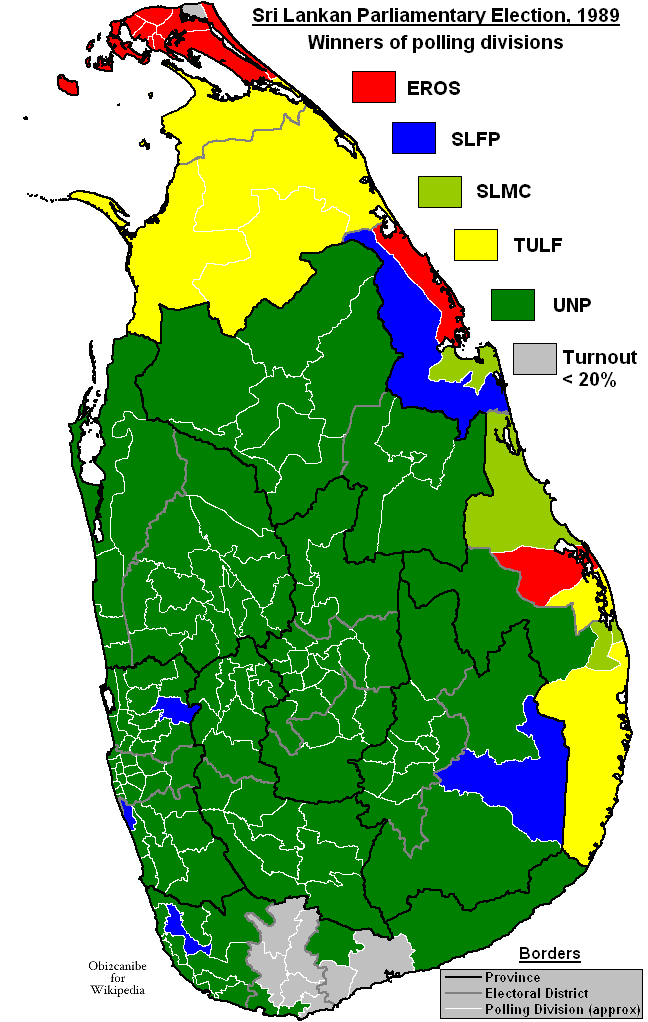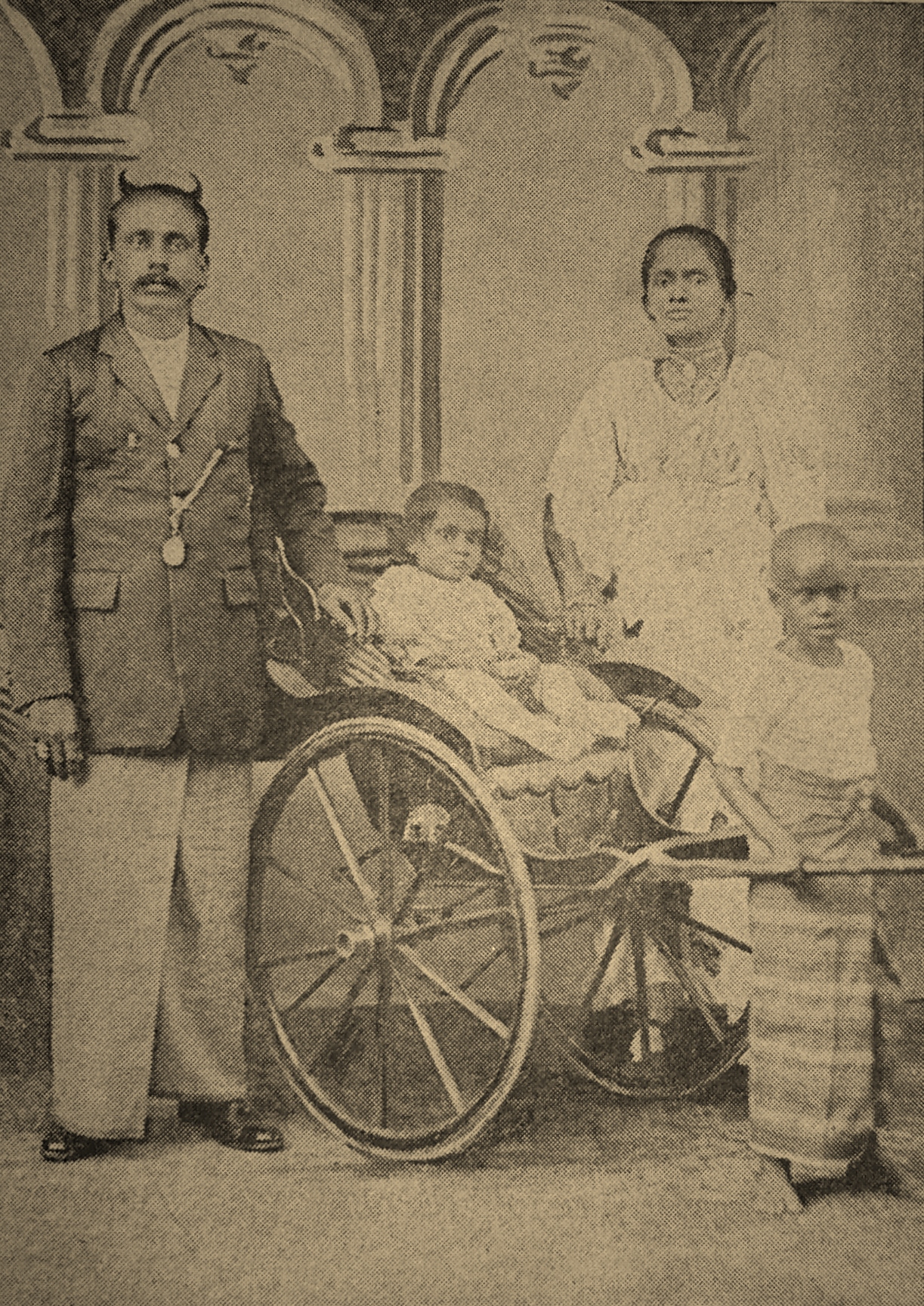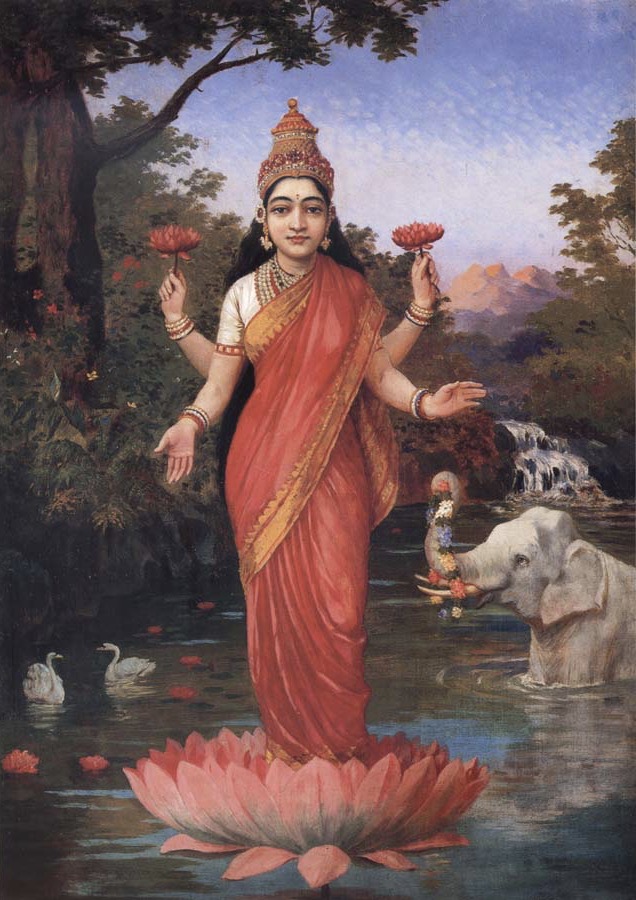|
9th Sri Lankan Parliament
The 9th Parliament of Sri Lanka was a meeting of the Parliament of Sri Lanka, with the membership determined by the results of the 1989 parliamentary election held on 15 February 1989. The parliament met for the first time on 9 March 1989 and was dissolved on 24 June 1994. Election The 9th parliamentary election was held on 15 February 1989. The incumbent United National Party (UNP) retained control of parliament by winning 125 of the 225 seats. The Sri Lanka Freedom Party (SLFP), the main opposition party, won 67 seats. The Eelam Revolutionary Organisation of Students (EROS), a Tamil militant group, won 13 seats contesting as independent groups whilst an alliance of Tamil parties ( TULF/ ENDLF/ EPRLF/ TELO) won 10 seats. Smaller parties won the remaining 10 seats. Results The new parliament was sworn in on 9 March 1989. M. H. Mohamed was elected Speaker, Gamini Fonseka was elected Deputy Speaker and Ariya B. Rekawa was elected Deputy Chairman of Committees. Governmen ... [...More Info...] [...Related Items...] OR: [Wikipedia] [Google] [Baidu] |
Parliament Of Sri Lanka
The Parliament of the Democratic Socialist Republic of Sri Lanka (Sinhala: ශ්රී ලංකා පාර්ලිමේන්තුව ''Shri Lanka Parlimenthuwa'', Tamil: இலங்கை நாடாளுமன்றம் ''Ilaṅkai nāṭāḷumaṉṟam'') is the supreme legislative body of Sri Lanka. It alone possesses legislative supremacy and thereby ultimate power over all other political bodies in the island. It is modeled after the British Parliament. It consists of 225 members known as Members of Parliament (MPs). Members are elected by proportional representation for five-year terms, with universal suffrage. The President of Sri Lanka has the power to summon, suspend, prorogue, or terminate a legislative session and to dissolve the Parliament. President can dissolve Parliament only after the lapse of years or if majority of Members of Parliament requests him. The actions of the president to either suspend or dissolve the Parliament is subject to leg ... [...More Info...] [...Related Items...] OR: [Wikipedia] [Google] [Baidu] |
ENDLF
The Eelam National Democratic Liberation Front (ENDLF) is a former Indian backed Tamil militant group in Sri Lanka. It was formed in 1987 as an amalgamation of splinter groups from other militant groups ( Eelam People's Revolutionary Liberation Front, People's Liberation Organisation of Tamil Eelam, Tamil Eelam Liberation Organization). It is currently a pro-government paramilitary group and political party. In August 2011 it was reported that the party is to be deregistered. Formation Gnanapiragasam Gnanasekaran (alias Paranthan Rajan), a leading member of PLOTE, formed the ''Three Stars'' militant group with splinter groups of TELO and EPRLF after leaving PLOTE. In 1987, ''Three Stars'' merged with a PLOTE splinter group led by Jotheeswaran (alias Kannan) and an EPRLF splinter group led by Douglas Devananda to form the Eelam National Democratic Liberation Front. This was done with the support of the Research and Analysis Wing, the Indian intelligence agency. Devananda left t ... [...More Info...] [...Related Items...] OR: [Wikipedia] [Google] [Baidu] |
Cabinet Of Sri Lanka
In Sri Lanka, the Cabinet of Ministers is the council of ministers that form the central government of Sri Lanka. The body of senior ministers responsible and answerable to the Parliament of Sri Lanka. The President is a member of the cabinet and its head. The current cabinet is the Wickremesinghe cabinet, which consists of 15 members from August 2020. There are also 38 state ministers who are not members of the cabinet. Background The Executive Council of Ceylon was the Executive Council created in British Ceylon by the British colonial administration on the recommendations of the Colebrooke-Cameron Commission along with the Legislative Council of Ceylon, as the legislative body, on 13 March 1833. At its creation the Executive Council was headed by the Governor, along with five members appointed by the Governor. These five members were officials who held the posts of the Colonial Secretary, the Attorney General, the Auditor-General, the Treasurer and the General Of ... [...More Info...] [...Related Items...] OR: [Wikipedia] [Google] [Baidu] |
Ranasinghe Premadasa
Sri Lankabhimanya Ranasinghe Premadasa ( si, රණසිංහ ප්රේමදාස ''Raṇasiṃha Premadāsa'', ta, ரணசிங்க பிரேமதாசா ''Raṇaciṅka Pirēmatācā''; 23 June 1924 – 1 May 1993) was the third President of Sri Lanka from 2 January 1989 to 1 May 1993. Before that, he served as the prime minister in the government headed by J. R. Jayewardene from 6 February 1978 to 1 January 1989. He was awarded Sri Lanka's highest award to a civilian Sri Lankabhimanya in 1986 by President Junius Richard Jayewardene, the first to receive in Sri Lankan history. Early life Ranasinghe Premadasa was born on 23 June 1924 at Dias Place, Colombo 11, to the family of Richard Ranasinghe (Ranasinghe Mudalali) of Kosgoda and Battuwita Jayasinghe Arachchige Ensina Hamine of Batuwita, Horana. Premadasa was the oldest of five children, three sisters, and one brother. His father was engaged in the transport business in Colombo employing rickshaws. H ... [...More Info...] [...Related Items...] OR: [Wikipedia] [Google] [Baidu] |
Mahajana Eksath Peramuna
The Mahajana Eksath Peramuna (People's United Front) is a political party in Sri Lanka Sri Lanka (, ; si, ශ්රී ලංකා, Śrī Laṅkā, translit-std=ISO (); ta, இலங்கை, Ilaṅkai, translit-std=ISO ()), formerly known as Ceylon and officially the Democratic Socialist Republic of Sri Lanka, is an .... The party is currently led by Prime minister of Sri Lanka, Prime Minister Dinesh Gunawardena, son of Philip Gunawardena, the founder of the party. History Under Philip Gunawardena The MEP was founded in 1959 by Philip Gunawardena and PH William de Silva. The party was named after the Mahajana Eksath Peramuna (1956), an SLFP-led alliance which Gunawardena was a member of, after its disbandment that year. During the March 1960 Ceylonese parliamentary election, March 1960 Ceylonese parliamentary elections, the MEP obtained 10 parliamentary seats. In the 1960s the group joined with the Lanka Sama Samaja Party and the Communist Party of Sri La ... [...More Info...] [...Related Items...] OR: [Wikipedia] [Google] [Baidu] |
Sri Lanka Muslim Congress
The Sri Lanka Muslim Congress ( ta, சிறீலங்கா முஸ்லீம் காங்கிரஸ், translit=Srīlaṅkā Muslīm Kāṅkiras; si, ශ්රී ලංකා මුස්ලිම් කොංග්රසය ''Sri Lanka Muslim Kongrasaya'') is a political party in Sri Lanka. It is one of the parties that represents the Muslim community of Sri Lanka. History The party was formed at a meeting held at Kalmunai in 1981 by a small study group of local Eastern Province political leaders. The group was pioneered by Congress Leader, M. H. M. Ashraff. About the Party Note about SLMC from the website Sri Lanka Muslim Congress (SLMC) is a political party that is totally focused on giving voice to the Muslim minority who comprises 8% of the island's population. It is Islamic centric but is committed to foster multiracial amity and collective prosperity for all Sri Lankan citizens. It firmly believes that Sri Lankan Muslims Islam is the t ... [...More Info...] [...Related Items...] OR: [Wikipedia] [Google] [Baidu] |
Tamil Eelam Liberation Organization
The Tamil Eelam Liberation Organization (TELO) is an Eelam Tamil organisation which campaigned for the establishment of an independent Tamil Eelam in the northeast of Sri Lanka during 1972-1987 which later accepted the December 19th proposals. The TELO was originally created as a militant group, and functioned as such until 1986, when most of its membership was killed in a conflict with the Liberation Tigers of Tamil Eelam (LTTE). Its surviving members reorganised themselves as a political party, and it continues to function as such today. The TELO currently has two Members of Parliament. It is part of the Tamil National Alliance, a coalition of Tamil parties which won 2.9% of the popular vote and 14 out of 225 seats at the 2010 parliamentary election in Sri Lanka. Early history The TELO evolved out of the group of Tamil student radicals formed by Nadarajah Thangathurai and Selvarajah Yogachandran (better known by his nom de guerre ''Kuttimani'') in the late 1960s. The grou ... [...More Info...] [...Related Items...] OR: [Wikipedia] [Google] [Baidu] |
Eelam People's Revolutionary Liberation Front
The Eelam People's Revolutionary Liberation Front (EPRLF) is a series of Sri Lankan political parties and a former militant separatist group. Militant separatists The EPRLF was formed in 1980 by K. Pathmanabha (Padmanaba), Douglas Devananda, Suresh Premachandran and Varatharajah Perumal as a breakaway faction of the Eelam Revolutionary Organisation of Students. In 1982 the EPRLF formed a military wing, ''People's Liberation Army'', headed by Douglas Devananda. The PLA is believed to have received military training by the Popular Front for the Liberation of Palestine. In early 1986 disputes amongst the EPRLF leadership led to it splitting into two factions: ''EPRLF (Ranjan)'' and ''EPRLF (Douglas)''. In late 1986 the Tamil Tigers attacked the EPRLF, inflicting heavy losses. Many of its cadres were killed or taken prisoner and its camps and weapons were seized by the Tigers. Douglas Devananda was blamed for the debacle. In 1987 the ''EPRLF (Douglas)'' faction formally split fro ... [...More Info...] [...Related Items...] OR: [Wikipedia] [Google] [Baidu] |
Eelam National Democratic Liberation Front
The Eelam National Democratic Liberation Front (ENDLF) is a former Indian backed Tamil militant group in Sri Lanka. It was formed in 1987 as an amalgamation of splinter groups from other militant groups (Eelam People's Revolutionary Liberation Front, People's Liberation Organisation of Tamil Eelam, Tamil Eelam Liberation Organization). It is currently a pro-government paramilitary group and political party. In August 2011 it was reported that the party is to be deregistered. Formation Gnanapiragasam Gnanasekaran (alias Paranthan Rajan), a leading member of PLOTE, formed the ''Three Stars'' militant group with splinter groups of TELO and EPRLF after leaving PLOTE. In 1987, ''Three Stars'' merged with a PLOTE splinter group led by Jotheeswaran (alias Kannan) and an EPRLF splinter group led by Douglas Devananda to form the Eelam National Democratic Liberation Front. This was done with the support of the Research and Analysis Wing, the Indian intelligence agency. Devananda left the EN ... [...More Info...] [...Related Items...] OR: [Wikipedia] [Google] [Baidu] |
Tamil United Liberation Front
The Tamil United Liberation Front ( ta, தமிழர் ஐக்கிய விடுதலை முன்னணி, translit=Tamil Onrupattatu Viduthulai Munnai, si, ද්රවිඩ එක්සත් විමුක්ති පෙරමුණ, translit= Dravida Eksath Vimukthi Peramuna) is a political party in Sri Lanka. Formation On 4 May 1972, several Tamil political groups, including the Federal Party (ITAK), Ceylon Workers Congress, and All Ceylon Tamil Congress formed the Tamil United Front (TUF) under the joint leadership of S.J.V. Selvanayagam, S. Thondaman, and G.G. Ponnambalam. The TUF changed its name to Tamil United Liberation Front (TULF) and adopted the demand for an independent state to be known as the "secular, socialist state of Tamil Eelam". The CWC declined to extend its support to the newly formed TULF. 1977 Parliamentary General Election In the first general election contested by the TULF, the 1977 Sri Lankan parliamentary election, in which ... [...More Info...] [...Related Items...] OR: [Wikipedia] [Google] [Baidu] |
Sri Lanka Parliament 1989
Shri (; , ) is a Sanskrit term denoting resplendence, wealth and prosperity, primarily used as an honorific. The word is widely used in South and Southeast Asian languages such as Marathi, Malay (including Indonesian and Malaysian), Javanese, Balinese, Sinhala, Thai, Tamil, Telugu, Hindi, Nepali, Malayalam, Kannada, Sanskrit, Pali, Khmer, and also among Philippine languages. It is usually transliterated as ''Sri'', ''Sree'', ''Shri'', Shiri, Shree, ''Si'', or ''Seri'' based on the local convention for transliteration. The term is used in Indian subcontinent and Southeast Asia as a polite form of address equivalent to the English "Mr." in written and spoken language, but also as a title of veneration for deities or as honorific title for local rulers. Shri is also another name for Lakshmi, the Hindu goddess of wealth, while a '' yantra'' or a mystical diagram popularly used to worship her is called Shri Yantra. Etymology Monier-Williams Dictionary gives th ... [...More Info...] [...Related Items...] OR: [Wikipedia] [Google] [Baidu] |
Sri Lankan Parliamentary Election 1989
Shri (; , ) is a Sanskrit term denoting resplendence, wealth and prosperity, primarily used as an honorific. The word is widely used in South and Southeast Asian languages such as Marathi, Malay (including Indonesian and Malaysian), Javanese, Balinese, Sinhala, Thai, Tamil, Telugu, Hindi, Nepali, Malayalam, Kannada, Sanskrit, Pali, Khmer, and also among Philippine languages. It is usually transliterated as ''Sri'', ''Sree'', ''Shri'', Shiri, Shree, ''Si'', or ''Seri'' based on the local convention for transliteration. The term is used in Indian subcontinent and Southeast Asia as a polite form of address equivalent to the English "Mr." in written and spoken language, but also as a title of veneration for deities or as honorific title for local rulers. Shri is also another name for Lakshmi, the Hindu goddess of wealth, while a '' yantra'' or a mystical diagram popularly used to worship her is called Shri Yantra. Etymology Monier-Williams Dictionary gives th ... [...More Info...] [...Related Items...] OR: [Wikipedia] [Google] [Baidu] |






